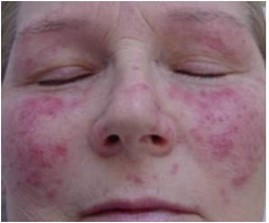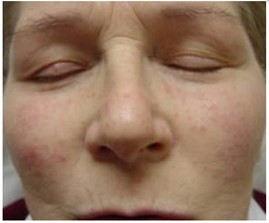Laser Rosacea Treatment
What is Rosacea?
Rosacea is a skin condition that can cause flushing, redness, spots and noticeable blood vessels; usually on your cheeks and nose. You may have some or all of these symptoms. The condition can be more severe in some people than others and it can also come and go over time.
Rosacea sometimes looks like acne and other skin disorders. It’s a lifelong skin condition that affects about one in 10 people over the age of 30. People who are fair-skinned are more likely to get rosacea. It’s more common in women, but the symptoms are often more severe in men.
The exact causes of rosacea are not known although a number of factors are said to influence it.
- Damage to the skin by sunlight can cause the degeneration of elastic in tissue which can in turn increase the likelihood of visible blood vessels.
- Higher number of mites called demodex folliculum
- Genetics
- External triggers to skin peptides like
- UV Light
- Spicy foods
- Alcohol
- Stress
- Exercise
- Heat
- Cold
It is the presence of these peptides which can affect the vascular supply to the skin. Again this can cause a dilation of the blood vessels.
Treatment options for Rosacea
As far as is known there is as yet no known cure for Rosacea but they are treatments available for the control of the condition. The treatment regime no matter what it is can be long and includes self-help as well as medication or laser treatment.
- Self Help
- Avoid triggers like sunlight
- Good skin care regime
- Use make-up to disguise
- Topical creams
- Oral medications
- Laser and IPL treatments
How laser treatment off Rosacea works.
When necessary, lasers may be used to reduce extensive redness, correct nose disfigurement and eradicate visible blood vessels. A gentle skin-care routine can be invaluable in helping to control Rosacea. In general, non-irritating skin-care products are advisable and protection from sun exposure by using a strong sunscreen also helps.
Both laser and intense pulsed light units produce a narrow beam of light energy. This beam of energy is directed towards the visible blood vessels in the skin. The energy is then absorbed by the target chromophore, which in this case is the blood causing damage to the blood vessels resulting in their shrinkage. The structural change leads to the body no longer recognising the proteins in the vessel wall, and these are then removed by the body’s immune system
The procedure is quick and easily administrated, with results often seen immediately but a course of treatments is going to ensure the best possible results. The laser or intense pulsed light treatment is unlikely to cause scarring or damage to the surround area.
Some of the side effects of the laser treatment though can be:
- Bruising
- Swelling
- Crusting of the skin
- Rarely cases of blisters
- Rare cases of infection
Any such side-effects will generally only last a few days
Which laser is best to use?
Some of the higher-end Intense Pulsed Light system deliver very good results for the treatment of Rosacea. In addition, vascular laser utilising the 1064nm (Nd:Yag) and 532nm (KTP) wavelengths also offer very good results as the target haemoglobin ie red.
Pre and Post treatment Images

Rosacea, prior to treatment (Above) and following laser treatment (Below)

